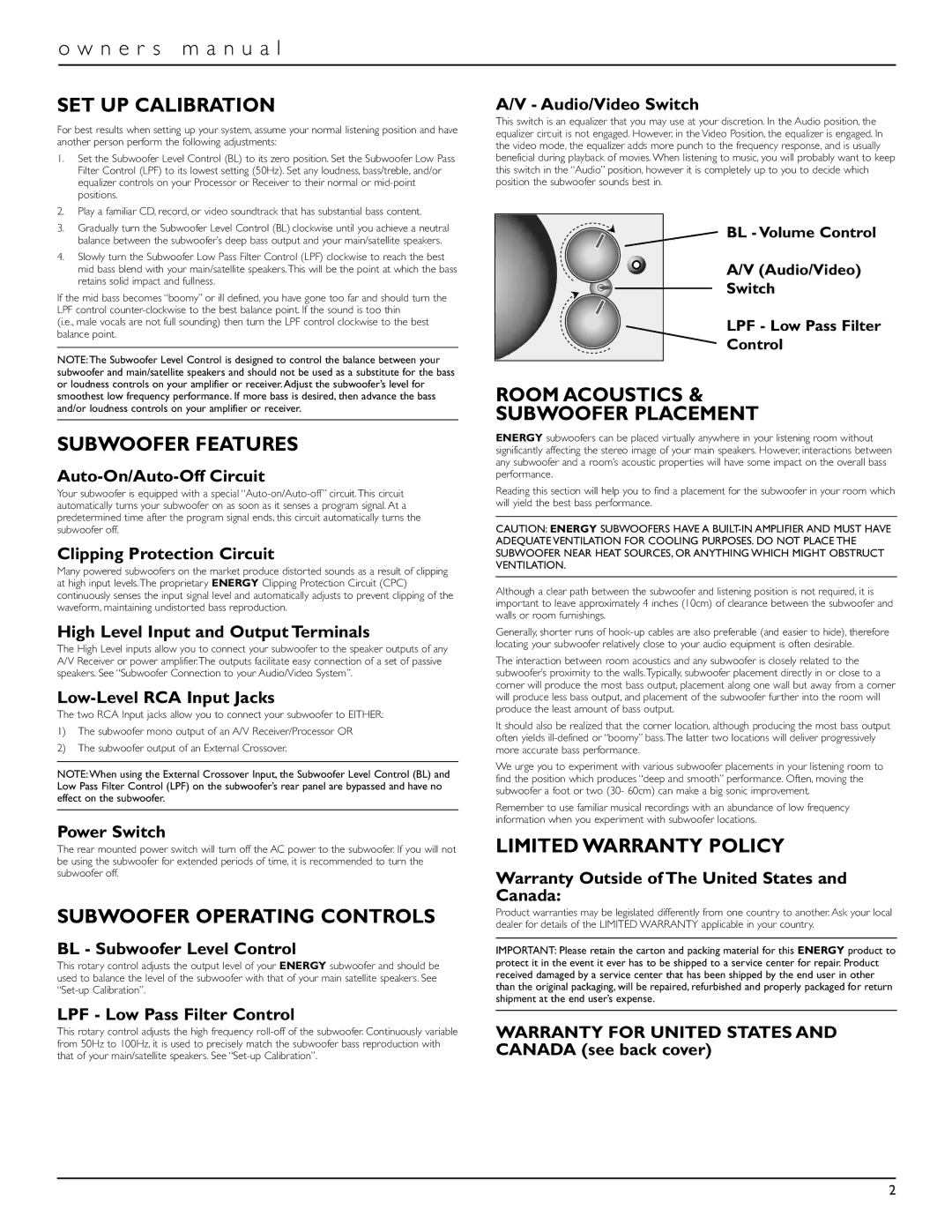
o w n e r s m a n u a l
SET UP CALIBRATION
For best results when setting up your system, assume your normal listening position and have another person perform the following adjustments:
1.Set the Subwoofer Level Control (BL) to its zero position. Set the Subwoofer Low Pass Filter Control (LPF) to its lowest setting (50Hz). Set any loudness, bass/treble, and/or equalizer controls on your Processor or Receiver to their normal or
2.Play a familiar CD, record, or video soundtrack that has substantial bass content.
3.Gradually turn the Subwoofer Level Control (BL) clockwise until you achieve a neutral balance between the subwoofer’s deep bass output and your main/satellite speakers.
4.Slowly turn the Subwoofer Low Pass Filter Control (LPF) clockwise to reach the best mid bass blend with your main/satellite speakers.This will be the point at which the bass retains solid impact and fullness.
If the mid bass becomes “boomy” or ill defined, you have gone too far and should turn the LPF control
(i.e., male vocals are not full sounding) then turn the LPF control clockwise to the best balance point.
NOTE:The Subwoofer Level Control is designed to control the balance between your subwoofer and main/satellite speakers and should not be used as a substitute for the bass or loudness controls on your amplifier or receiver. Adjust the subwoofer’s level for smoothest low frequency performance. If more bass is desired, then advance the bass and/or loudness controls on your amplifier or receiver.
SUBWOOFER FEATURES
Auto-On/Auto-Off Circuit
Your subwoofer is equipped with a special
Clipping Protection Circuit
Many powered subwoofers on the market produce distorted sounds as a result of clipping at high input levels.The proprietary ENERGY Clipping Protection Circuit (CPC) continuously senses the input signal level and automatically adjusts to prevent clipping of the waveform, maintaining undistorted bass reproduction.
High Level Input and Output Terminals
The High Level inputs allow you to connect your subwoofer to the speaker outputs of any A/V Receiver or power amplifier.The outputs facilitate easy connection of a set of passive speakers. See “Subwoofer Connection to your Audio/Video System”.
Low-Level RCA Input Jacks
The two RCA Input jacks allow you to connect your subwoofer to EITHER:
1)The subwoofer mono output of an A/V Receiver/Processor OR
2)The subwoofer output of an External Crossover.
NOTE:When using the External Crossover Input, the Subwoofer Level Control (BL) and Low Pass Filter Control (LPF) on the subwoofer’s rear panel are bypassed and have no effect on the subwoofer.
Power Switch
The rear mounted power switch will turn off the AC power to the subwoofer. If you will not be using the subwoofer for extended periods of time, it is recommended to turn the subwoofer off.
SUBWOOFER OPERATING CONTROLS
BL - Subwoofer Level Control
This rotary control adjusts the output level of your ENERGY subwoofer and should be used to balance the level of the subwoofer with that of your main satellite speakers. See
LPF - Low Pass Filter Control
This rotary control adjusts the high frequency
A/V - Audio/Video Switch
This switch is an equalizer that you may use at your discretion. In the Audio position, the equalizer circuit is not engaged. However, in the Video Position, the equalizer is engaged. In the video mode, the equalizer adds more punch to the frequency response, and is usually beneficial during playback of movies. When listening to music, you will probably want to keep this switch in the “Audio” position, however it is completely up to you to decide which position the subwoofer sounds best in.
![]()
![]() BL - Volume Control
BL - Volume Control
A/V (Audio/Video)
Switch
LPF - Low Pass Filter
Control
ROOM ACOUSTICS &
SUBWOOFER PLACEMENT
ENERGY subwoofers can be placed virtually anywhere in your listening room without significantly affecting the stereo image of your main speakers. However, interactions between any subwoofer and a room’s acoustic properties will have some impact on the overall bass performance.
Reading this section will help you to find a placement for the subwoofer in your room which will yield the best bass performance.
CAUTION: ENERGY SUBWOOFERS HAVE A
Although a clear path between the subwoofer and listening position is not required, it is important to leave approximately 4 inches (10cm) of clearance between the subwoofer and walls or room furnishings.
Generally, shorter runs of
The interaction between room acoustics and any subwoofer is closely related to the subwoofer’s proximity to the walls.Typically, subwoofer placement directly in or close to a corner will produce the most bass output, placement along one wall but away from a corner will produce less bass output, and placement of the subwoofer further into the room will produce the least amount of bass output.
It should also be realized that the corner location, although producing the most bass output often yields
We urge you to experiment with various subwoofer placements in your listening room to find the position which produces “deep and smooth” performance. Often, moving the subwoofer a foot or two (30- 60cm) can make a big sonic improvement.
Remember to use familiar musical recordings with an abundance of low frequency information when you experiment with subwoofer locations.
LIMITED WARRANTY POLICY
Warranty Outside of The United States and Canada:
Product warranties may be legislated differently from one country to another. Ask your local dealer for details of the LIMITED WARRANTY applicable in your country.
IMPORTANT: Please retain the carton and packing material for this ENERGY product to protect it in the event it ever has to be shipped to a service center for repair. Product received damaged by a service center that has been shipped by the end user in other than the original packaging, will be repaired, refurbished and properly packaged for return shipment at the end user’s expense.
WARRANTY FOR UNITED STATES AND CANADA (see back cover)
2
